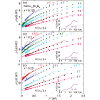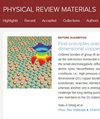Quantum criticality linked to the suppressed superconducting upper critical field in Ni-doped CeCoIn5
IF 3.4
3区 材料科学
Q2 MATERIALS SCIENCE, MULTIDISCIPLINARY
引用次数: 0
Abstract
We demonstrate a close connection between the quantum critical point (QCP) and superconducting upper critical field in the Ni-doped heavy-fermion superconductor . Temperature variations of electrical resistivity exhibit a crossover between the non-Fermi liquid and the Fermi liquid states, whose boundary for , regarded as the QCP, coincides with , while decreases to zero with increasing Ni concentrations up to 25%. Furthermore, the coefficient of the term in estimated in the Fermi liquid region shows the diverging behavior with decreasing the magnetic field toward . These experimental results suggest that the emergence of the QCP is always accompanied by the breakdown of the superconducting state by in Ni-doped .

量子临界与掺镍 CeCoIn5 中被抑制的超导上临界场有关
我们证明了掺镍重费米子超导体 CeCoIn5 中量子临界点 (QCP) 与超导上临界磁场 Hc2 之间的密切联系。电阻率ρ(T)的温度变化显示了非费米液体态和费米液体态之间的交叉,其 T→0 的边界(被视为 QCP)与 Hc2 重合,而 Hc2 随着镍浓度增加至 25% 而降至零。此外,在费米液体区估算的 ρ(T) 中 T2 项的 A 系数显示出随着磁场 H 减小而向 Hc2 发散的行为。这些实验结果表明,在掺镍 CeCoIn5 中,QCP 的出现总是伴随着 H 对超导态的击穿。
本文章由计算机程序翻译,如有差异,请以英文原文为准。
求助全文
约1分钟内获得全文
求助全文
来源期刊

Physical Review Materials
Physics and Astronomy-Physics and Astronomy (miscellaneous)
CiteScore
5.80
自引率
5.90%
发文量
611
期刊介绍:
Physical Review Materials is a new broad-scope international journal for the multidisciplinary community engaged in research on materials. It is intended to fill a gap in the family of existing Physical Review journals that publish materials research. This field has grown rapidly in recent years and is increasingly being carried out in a way that transcends conventional subject boundaries. The journal was created to provide a common publication and reference source to the expanding community of physicists, materials scientists, chemists, engineers, and researchers in related disciplines that carry out high-quality original research in materials. It will share the same commitment to the high quality expected of all APS publications.
 求助内容:
求助内容: 应助结果提醒方式:
应助结果提醒方式:


